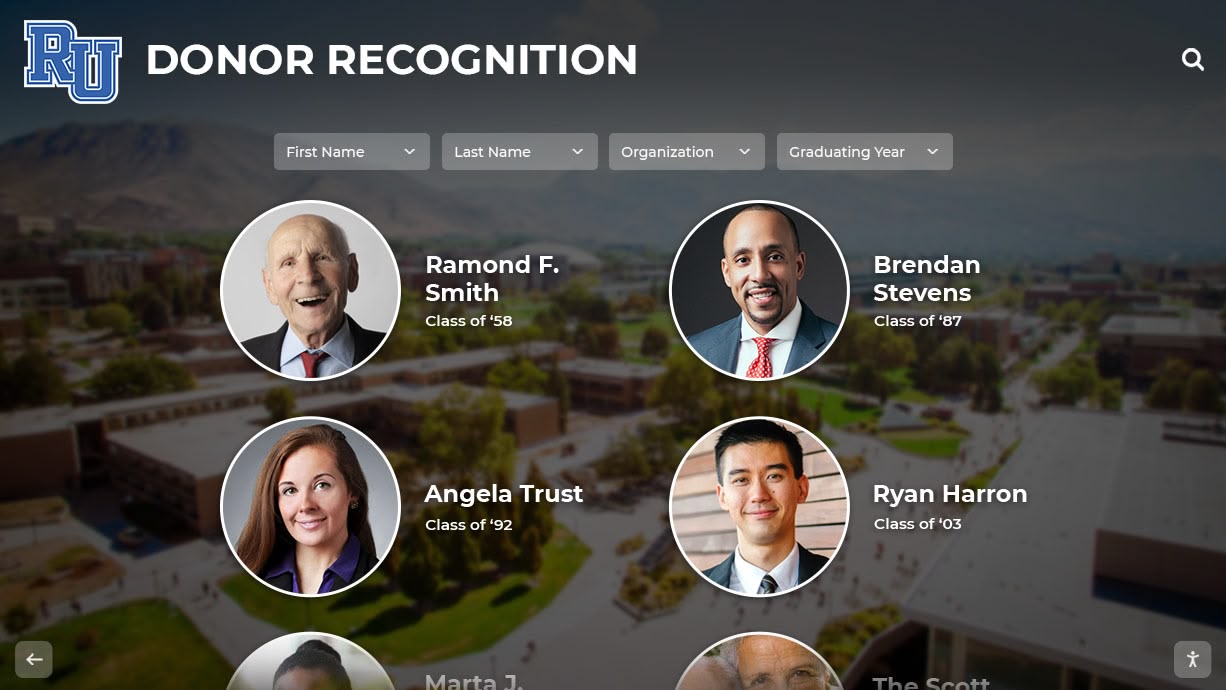Key Takeaways
Discover how to create an impactful alumni donors wall of honor. Learn best practices for recognizing philanthropic contributions through modern digital displays and traditional approaches.
The Strategic Importance of Donor Recognition
Educational institutions face a fundamental challenge: retaining donors costs significantly less than acquiring new ones, yet many organizations struggle with recognition systems that fail to acknowledge contributions meaningfully. Research consistently demonstrates that recognized donors give again at higher rates, contribute larger subsequent gifts, and maintain longer relationships with institutions.
An alumni donors wall of honor addresses this challenge by creating visible, permanent acknowledgment that demonstrates institutional gratitude while providing social validation encouraging others to give. When prospective donors see comprehensive recognition of community support, they gain confidence that their contributions will be valued and celebrated appropriately.
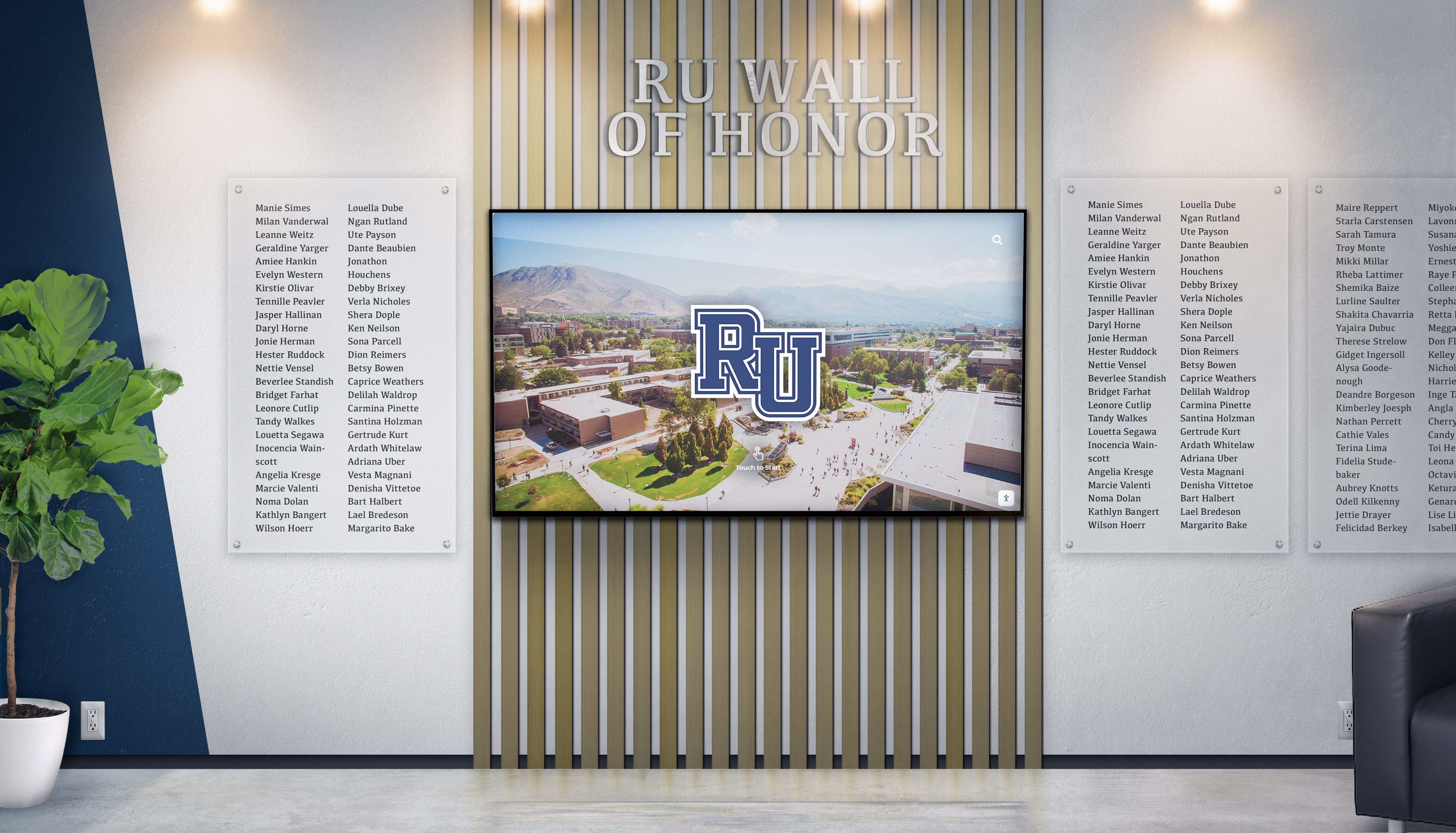
Why Alumni Donors Deserve Distinguished Recognition
Alumni donors represent unique stakeholders who combine personal institutional connection with financial commitment. Unlike external foundation grants or corporate partnerships, alumni giving reflects emotional investment rooted in personal experience and institutional loyalty.
These donors attended your classes, walked your hallways, formed lifelong friendships, and achieved their foundational education at your institution. When they choose to give back financially—often while managing competing obligations to family, mortgage payments, and retirement planning—their generosity deserves recognition that honors both the gift and the personal connection motivating it.
A properly designed donor recognition wall celebrates this unique relationship while encouraging continued philanthropic engagement across donors’ lifetimes.
Traditional vs. Modern Donor Recognition Approaches
Organizations implementing donor recognition programs must choose between traditional physical displays and contemporary digital solutions, each offering distinct advantages and limitations.
Traditional Physical Donor Walls
Classic donor recognition typically features engraved brass plaques, etched glass panels, or printed nameplates mounted on prominent walls in high-traffic areas. These displays provide tangible, permanent recognition familiar to donors across generations.
Advantages of Traditional Approaches:
- Timeless aesthetic appeal and perceived prestige
- No technology requirements or ongoing software costs
- Familiar format aligned with century-old recognition traditions
- Physical presence creating formal institutional atmosphere
Limitations of Physical Recognition:
- Fixed space capacity that eventually fills completely
- High per-donor costs ($75-$300+ per plaque) for each addition
- Lengthy fabrication timelines delaying acknowledgment
- Inability to update information or correct errors efficiently
- Static presentation without storytelling capabilities
- Limited accessibility for donors unable to visit physically
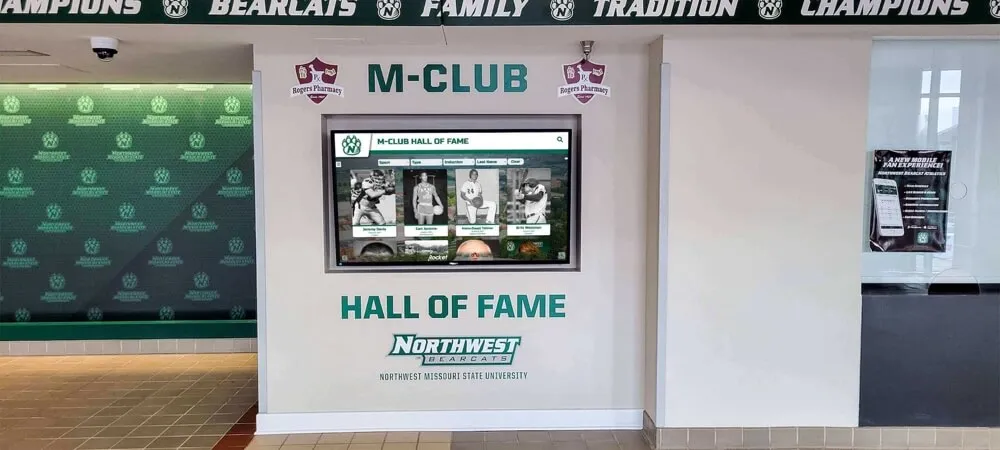
Digital Interactive Donor Recognition Walls
Modern recognition technology uses touchscreen displays and web-based platforms to create dynamic, engaging donor experiences that overcome traditional limitations while adding powerful new capabilities.
Key Advantages of Digital Recognition:
- Effectively unlimited capacity for recognizing donors at all levels
- Instant content updates without fabrication delays or physical installation
- Rich multimedia storytelling with photos, videos, and detailed narratives
- Interactive search enabling donors to find themselves immediately
- Remote accessibility through web-based companion platforms
- Comprehensive analytics tracking engagement and effectiveness
- Lower long-term costs by eliminating ongoing plaque fabrication expenses
Digital recognition solutions like Rocket Alumni Solutions provide purpose-built platforms specifically designed for educational institutions seeking to honor supporters without space or budget limitations. These systems combine professional presentation with intuitive content management that non-technical development staff can operate independently.
Hybrid Recognition Strategies
Many successful institutions discover that combining traditional and digital elements creates the most effective donor recognition experience. A hybrid approach might feature:
- Traditional engraved plaques for highest-tier major gift donors
- Digital touchscreens providing unlimited capacity for comprehensive recognition
- QR codes linking physical displays to detailed digital donor profiles
- Web platforms ensuring accessibility beyond campus visits for global alumni
This balanced strategy honors tradition while solving capacity limitations through technology, accommodating diverse donor preferences while maximizing recognition effectiveness.
Essential Components of Effective Alumni Donor Recognition
Exceptional donor recognition systems share common features ensuring they serve advancement needs effectively across decades of organizational growth and evolving campaigns.
Comprehensive Recognition Capacity
The best alumni donors walls of honor eliminate forced choices about which supporters deserve acknowledgment. Every major gift, every annual fund contributor, every planned giving commitment, and every memorial donation merits appropriate recognition.
Digital systems provide capacity for thousands of donor profiles across all giving levels, enabling institutions to celebrate:
- Lifetime giving societies at multiple tier levels
- Consecutive-years giving clubs recognizing loyalty
- Campaign-specific leadership recognition
- Legacy and planned giving commitments
- Corporate and foundation partnership acknowledgment
- Memorial and tribute donations honoring loved ones
- Volunteer leadership alongside financial contributions
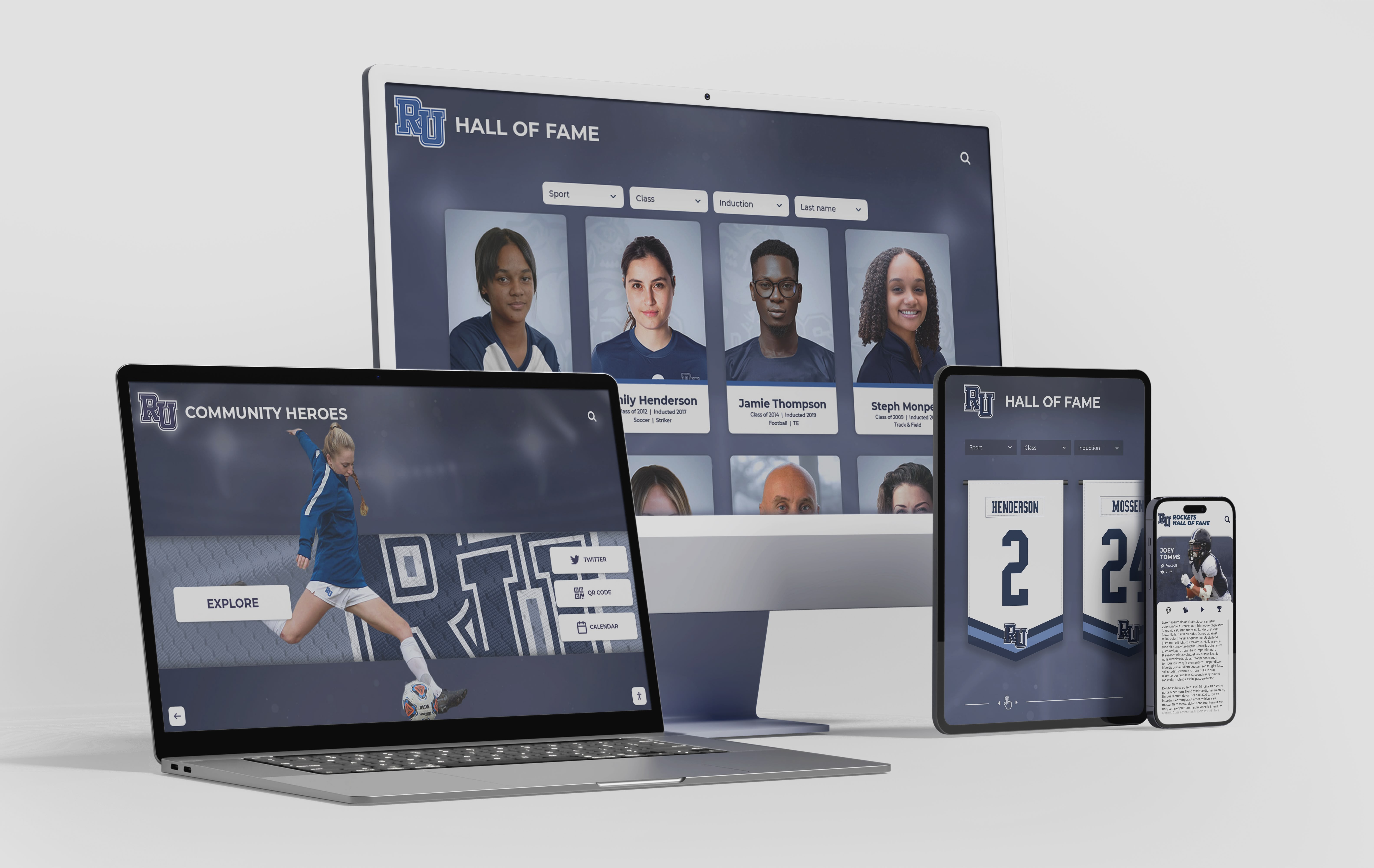
When space constraints disappear, institutions discover recognition abundance—celebrating generosity comprehensively rather than selectively based on arbitrary capacity limitations.
Intuitive Search and Navigation Features
Recognition value depends on discoverability. Alumni attending events or visiting campus should find their acknowledgment immediately through multiple pathways including name search functionality, filtered browsing by giving level or graduation year, campaign-specific recognition categories, and society membership displays.
Robust search allows donors to enter names and instantly locate their recognition. Family members discover loved ones’ memorial gifts immediately. Development officers demonstrate recognition to prospective major donors efficiently during campus tours, strengthening cultivation conversations with tangible evidence of appreciation culture.
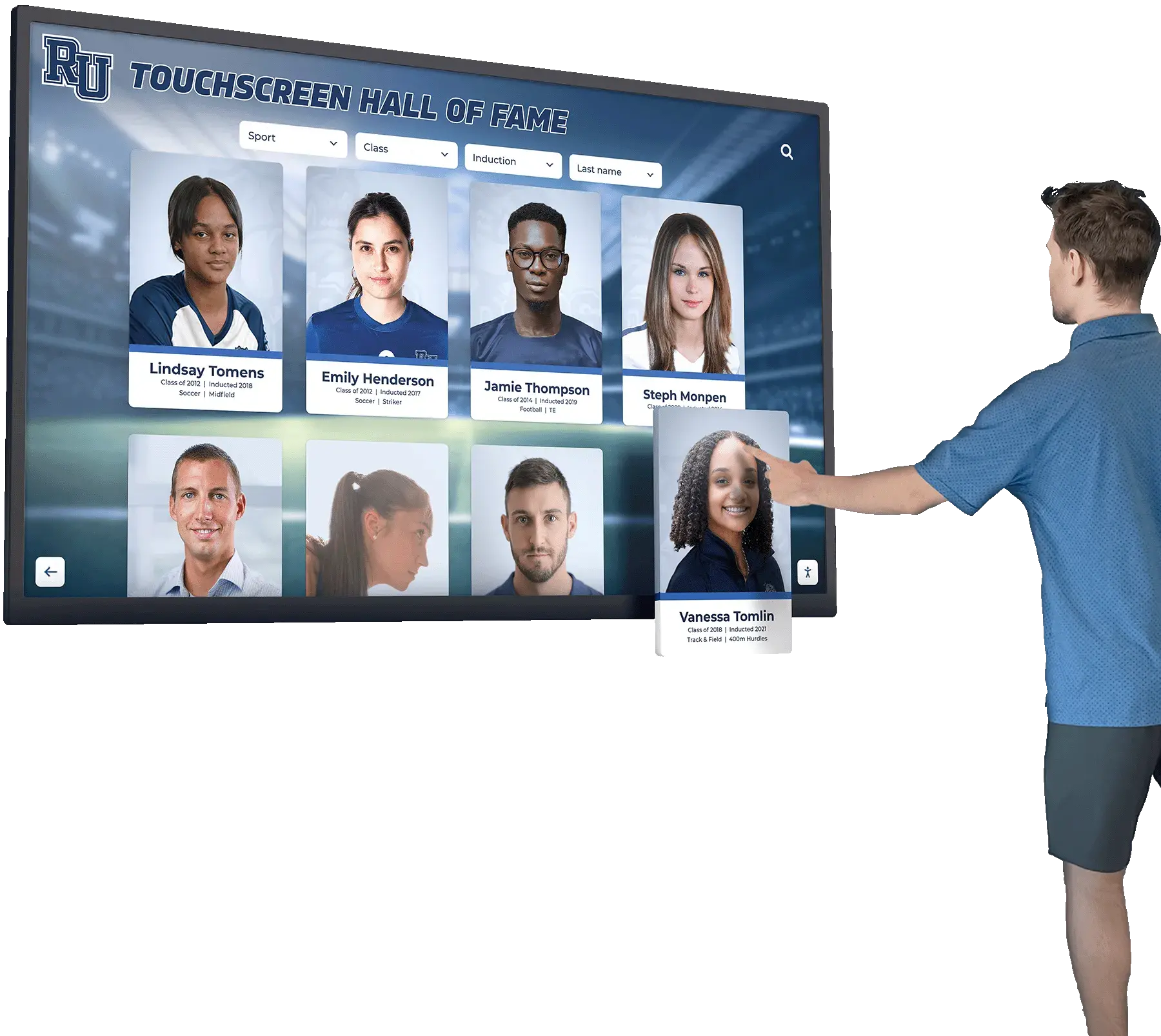
Rich Multimedia Storytelling
Text and statistics tell partial stories. The best donor recognition systems integrate comprehensive multimedia bringing generosity to life through high-resolution photos, video testimonials, and detailed narratives that create emotional connections.
Visual Storytelling Elements:
- Photos of donors at recognition events and facility dedications
- Multiple images per donor creating richer narratives than single static plaques
- Historical photos documenting organizational evolution donors funded
- Facility tour videos showcasing spaces contributors made possible
- Beneficiary testimonials describing impact on student experiences
Comprehensive donor profiles celebrate complete philanthropic journeys rather than reducing generosity to basic statistics. The most effective profiles include lifetime giving history showing progression over time, specific funds or programs supported, biographical information and institutional connections, personal reflections on motivation when donors provide them, and family legacy giving that spans multiple generations.
For institutions seeking to enhance donor engagement, multimedia integration proves particularly valuable in creating memorable experiences that strengthen emotional connections between donors and institutional mission.
Strategic Design Considerations for Donor Walls of Honor
Successful donor recognition results from systematic planning addressing organizational objectives, donor preferences, budget realities, and long-term sustainability requirements.
Establishing Recognition Tiers and Giving Societies
Thoughtful tier structure ensures all donors feel appropriately recognized while clearly communicating pathways to increased giving levels that development officers can reference during cultivation conversations.
Lifetime Giving Society Structure:
Many organizations structure primary recognition around cumulative giving tiers such as:
- Transformational Gifts ($1,000,000+): Highest recognition for gifts that fundamentally change institutional capabilities
- Visionary Society ($250,000-$999,999): Leadership donors enabling strategic initiatives
- Heritage Circle ($100,000-$249,999): Major donors making lasting institutional impact
- President’s Society ($50,000-$99,999): Significant contributors supporting key priorities
- Benefactors Club ($25,000-$49,999): Generous supporters enabling program expansion
- Leadership Circle ($10,000-$24,999): Committed donors demonstrating sustained support
- Patron Society ($5,000-$9,999): Loyal contributors building philanthropic foundation
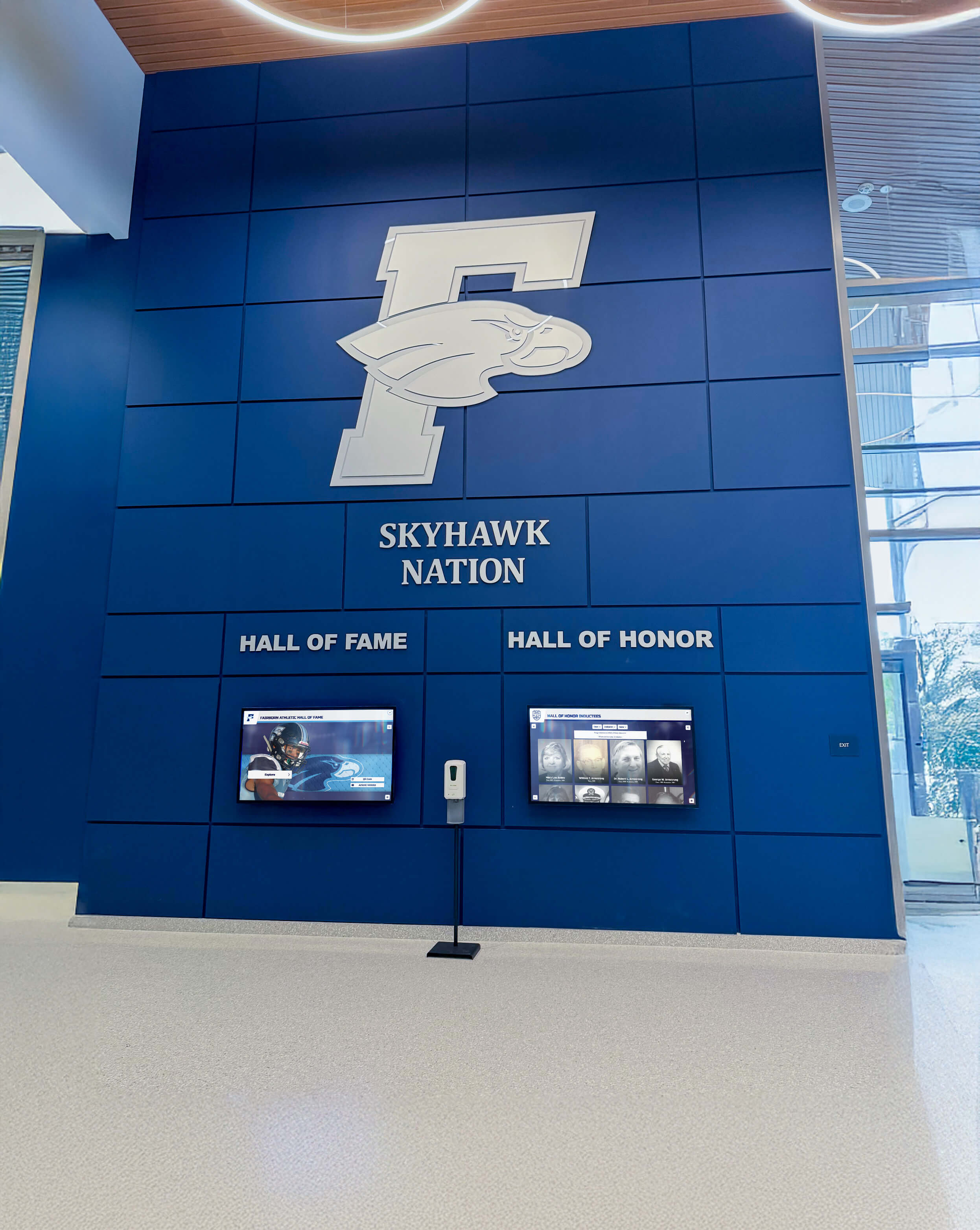
Annual Giving Recognition:
Complementary annual giving societies acknowledge consistent support including consecutive-years clubs (5, 10, 25+ years of continuous giving), annual leadership levels (top annual gifts each fiscal year), young alumni societies (recent graduates establishing giving habits), and reunion giving champions (class-based recognition encouraging friendly competition).
Special Recognition Categories:
Additional pathways honor diverse contributions including Legacy Society membership (documented planned gifts and bequests), Founder’s Circle (charter donors during critical early stages), Campaign Leadership (major gifts to specific capital initiatives), Matching Gift Champions (employer matching program maximizers), and Memorial Giving (tribute donations honoring departed community members).
Creating multiple recognition pathways ensures diverse types of support receive appropriate acknowledgment while providing development officers numerous angles for donor cultivation conversations. Understanding comprehensive donor recognition best practices helps institutions design tier structures that maximize both appreciation impact and fundraising effectiveness.
Location and Placement Strategy
Strategic placement dramatically impacts how effectively your alumni donors wall of honor engages your community and achieves recognition objectives while supporting active fundraising efforts.
Optimal High-Traffic Locations:
- Main entrance lobbies where all visitors pass naturally
- Outside development or advancement office suites where donors frequently visit
- Adjacent to auditoriums or event spaces hosting donor gatherings
- Near cafeterias or student gathering areas with sustained daily traffic
- Along primary hallways connecting building sections
Technical Considerations:
- Adequate lighting avoiding screen glare for digital displays
- Sufficient space for multiple simultaneous viewers without crowding
- ADA-compliant mounting heights and approach clearances
- Climate-controlled indoor environments protecting displays
- Network connectivity and power access for digital systems
- Sight lines drawing attention from multiple directions
For digital recognition displays, understanding hardware and infrastructure requirements ensures successful installation that delivers reliable performance across years of continuous operation.
Content Strategy for Maximum Impact
Compelling donor recognition requires thoughtful content strategy addressing what information to include, how to present it effectively, and how to maintain relevance over time.
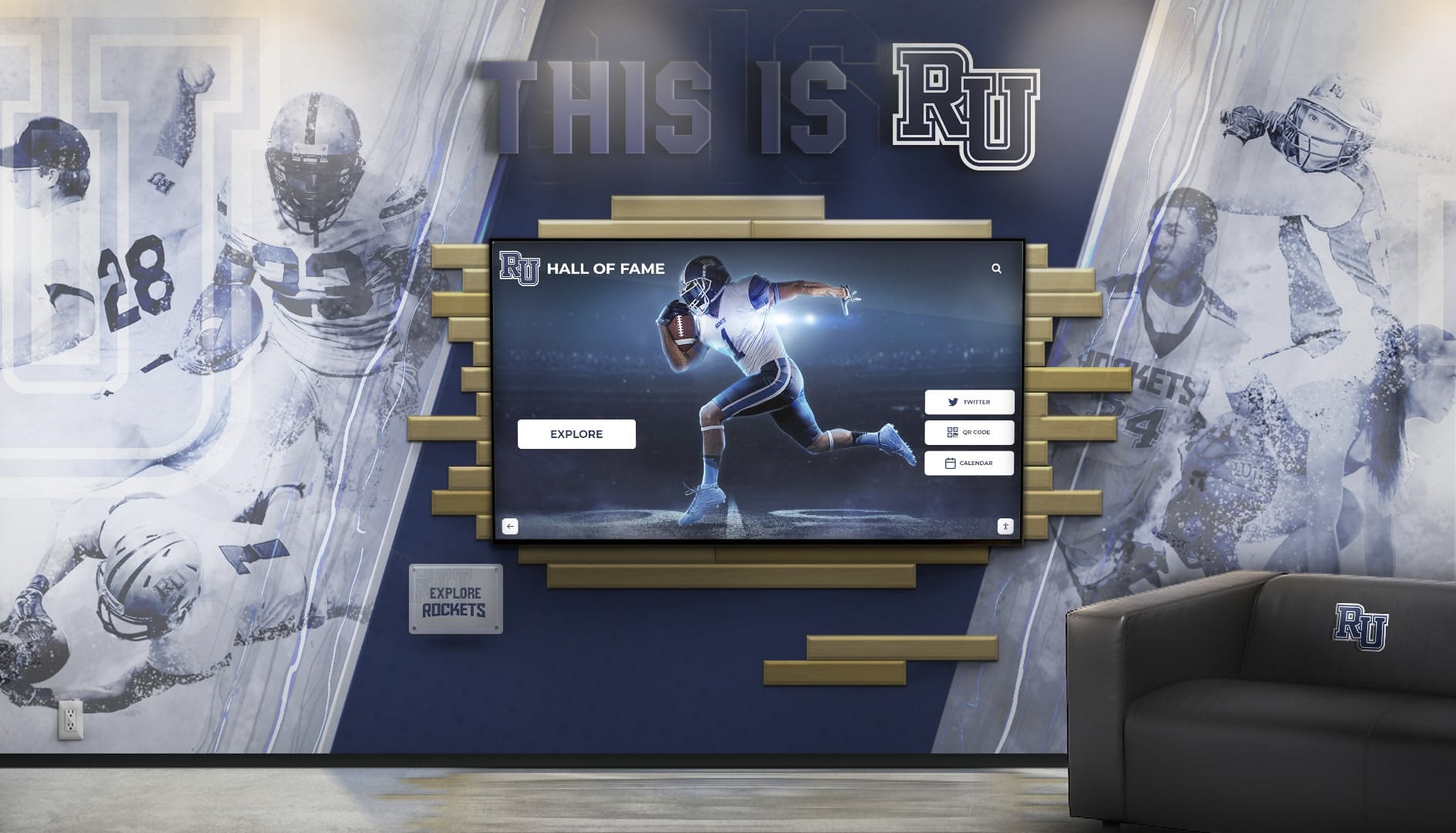
Essential Profile Information:
- Donor name(s) and recognition level
- Years of support or giving history
- Specific funds or programs supported
- Recognition society memberships
- Graduation year and degree information
- Geographic or professional affiliations when relevant
Enhanced Content Options:
- Professional donor photographs creating personal connections
- Brief biographical information highlighting institutional relationships
- Personal statements explaining motivation for giving
- Impact stories connecting donations to specific outcomes
- Video testimonials from donors or scholarship recipients
- Historical context about campaigns or initiatives supported
Privacy and Permission Protocols:
Respect for donor preferences remains paramount through clear opt-in/opt-out mechanisms for public recognition, donor control over information shared beyond basic acknowledgment, options for anonymous or partially anonymous recognition, processes for donors to review content before publication, and easy methods for updating preferences over time.
Implementation Best Practices and Timelines
Organizations achieving strongest recognition results follow systematic implementation approaches addressing planning, execution, training, and ongoing management.
Phase 1: Planning and Assessment (Weeks 1-4)
Begin by understanding current recognition state and defining clear objectives for new systems aligned with institutional fundraising strategies.
Current State Documentation:
- Inventory existing recognition displays and donor acknowledgment methods
- Document which supporters receive current recognition and what gaps exist
- Assess physical space available or identify need for purely digital approaches
- Evaluate stakeholder satisfaction through development staff and donor feedback
Objective Definition and Success Metrics:
- Establish clear goals: solving capacity constraints, improving donor retention, supporting campaign success
- Define measurable outcomes: retention rates, giving growth, recognition engagement, or campaign results
- Identify stakeholders for planning involvement: development directors, board members, marketing teams, facilities and IT staff
Budget Development:
- Initial hardware and software costs for chosen approach
- Installation and infrastructure expenses
- Content development time and resources
- Ongoing licensing and maintenance fees
- Staff time for program management and coordination
Many institutions fund recognition programs through operating budgets, capital campaign allocations, donor sponsorships for recognition technology specifically, or foundation grants focused on organizational capacity building.
Phase 2: Solution Selection and Content Development (Weeks 5-12)
Research available recognition platforms, evaluate demonstrations from qualified vendors, and begin comprehensive content development preparing for successful launch.
Vendor Evaluation Criteria:
- Feature completeness and quality against your specific requirements
- Content management ease for non-technical development staff
- Total cost of ownership including all ongoing expenses
- Vendor support quality and responsiveness
- Reference satisfaction from current customers in similar institutions
- Integration capabilities with existing fundraising databases
- Scalability for future expansion as donor base grows
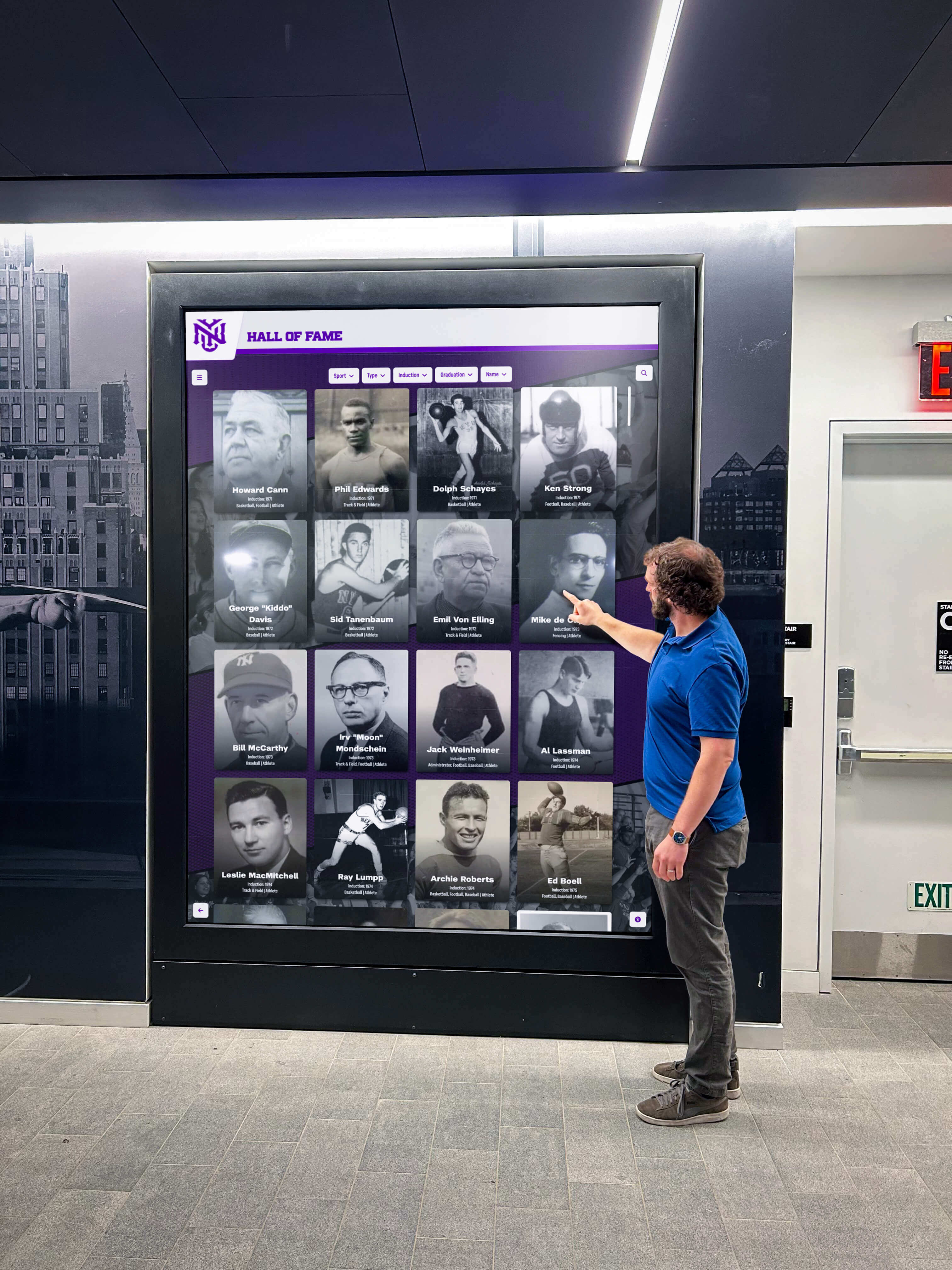
Content Development Process:
- Compile complete donor histories from fundraising databases and historical records
- Cross-reference information sources ensuring accuracy
- Collect photos, videos, and media assets through outreach campaigns
- Develop detailed donor profiles using consistent templates
- Establish quality control processes ensuring accuracy and appropriate tone
- Create logical content organization supporting multiple discovery pathways
This content development phase typically represents the most time-intensive implementation element but creates foundation for meaningful recognition that honors all supporters appropriately.
Phase 3: Installation and Launch (Weeks 13-16)
Execute professional installation, train staff thoroughly, test comprehensively, and launch publicly while celebrating donors meaningfully.
Installation Best Practices:
- Professional mounting following all safety codes and aesthetic standards
- Complete network connectivity and system configuration
- Comprehensive testing before soft launch with limited audiences
- Staff training on content management and system administration
- Documentation and quick-reference guides supporting independent operation
Public Launch Strategy:
- Formal unveiling ceremony with donor attendance and participation
- Board members and campaign volunteers engaged in celebration
- Media coverage for publicity extending recognition reach
- Promotion through organizational communications and social media
- Demonstration of features encouraging ongoing exploration
Successful launches generate awareness and excitement while celebrating donors meaningfully, setting positive tone for ongoing program success and community engagement.
Maximizing Fundraising Impact Through Recognition
Organizations viewing alumni donors walls of honor as strategic fundraising investments rather than passive acknowledgment achieve significantly stronger development outcomes through enhanced donor relationships.
Donor Retention and Giving Growth
Visible, meaningful recognition strengthens donor commitment by affirming philanthropic identity, demonstrating institutional appreciation tangibly, connecting contributors to broader community of supporters, and reinforcing satisfaction with giving decisions through public validation.
Organizations implementing comprehensive recognition typically report:
- Improved retention rates of 10-15 percentage points over institutions with minimal acknowledgment
- Increased average gift sizes from recognized donors feeling valued
- Higher upgrade rates as donors move from lower to higher giving tiers
- Improved planned giving inquiry rates from long-term supporters
These outcomes directly translate to enhanced fundraising capacity supporting institutional mission advancement while reducing costly donor acquisition requirements.
Campaign Success and Leadership Giving
Donor recognition walls support capital campaign success by providing visible social proof encouraging broader participation, highlighting leadership donors inspiring others to step forward at similar levels, demonstrating tangible progress toward goals maintaining momentum, and creating conversation tools for gift officers during major donor cultivation.
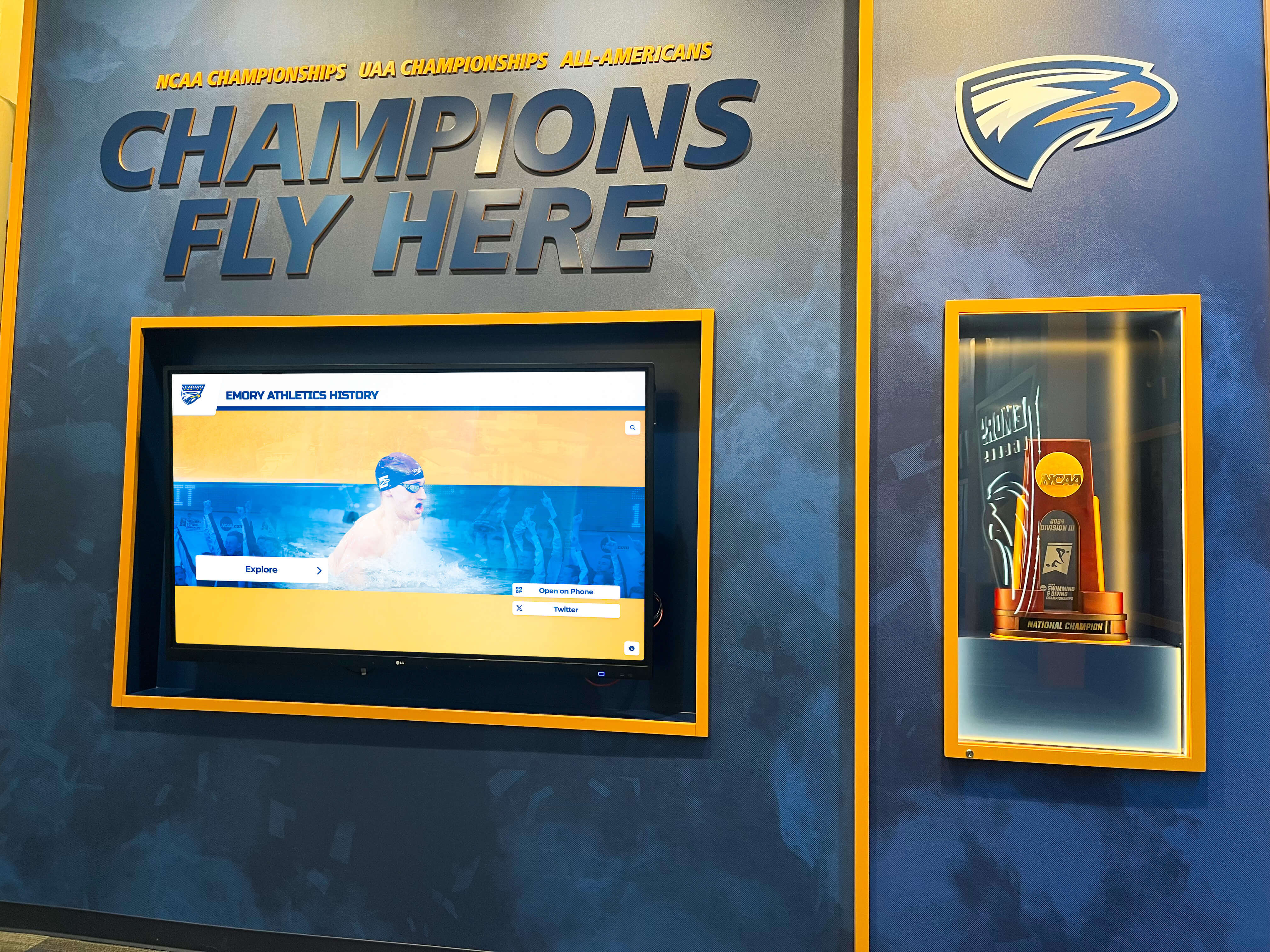
Campaign-specific recognition features prove particularly effective during active fundraising phases. Real-time progress tracking shows community momentum, leadership donor spotlighting creates aspiration for others, matching gift countdown timers generate urgency, and participation honor rolls encourage broader engagement.
Understanding how advancement and development teams leverage recognition strategically demonstrates integration with comprehensive fundraising programs beyond simple acknowledgment.
Alumni Engagement Beyond Financial Giving
Comprehensive recognition provides powerful tools for strengthening overall alumni engagement. When graduates see accomplishments honored publicly through donations or volunteer leadership, they develop stronger identification with alma mater influencing behavior across multiple dimensions.
Board members cite recognition quality during recruitment conversations with prospective governance leaders. Volunteers increase personal giving to maintain leadership visibility within their networks. Development committee members use recognition during prospect meetings, demonstrating institutional appreciation culture that influences major gift decision-making.
Maintaining Long-Term Program Excellence
Donor recognition walls require ongoing attention to maintain relevance, accuracy, and value across years and decades of institutional evolution.
Annual Addition Cycles and Content Refreshment
Establish predictable rhythms for adding new honorees through annual induction ceremonies, regular nomination periods, and scheduled display updates. Consistent cycles create anticipation while ensuring recognition remains current rather than static.
For digital platforms, updates happen instantly through software without physical modifications. Organizations should maintain engagement through profile enhancements adding newly discovered information or photos, featured donor rotations highlighting different supporters monthly, achievement updates as alumni reach new milestones, and themed collections around anniversaries or special topics.
Performance Monitoring and Analytics
Track meaningful metrics demonstrating program value including alumni engagement levels (giving rates, volunteer participation, event attendance), stakeholder feedback through donor surveys, visitor interaction data for digital systems with analytics capabilities, media coverage and social media reach, and nomination quality and quantity trends over time.
Use these metrics to report program value to institutional leadership, identify content performing particularly well with audiences, adjust strategies based on actual behavior patterns, and demonstrate return on investment justifying continued programmatic support.
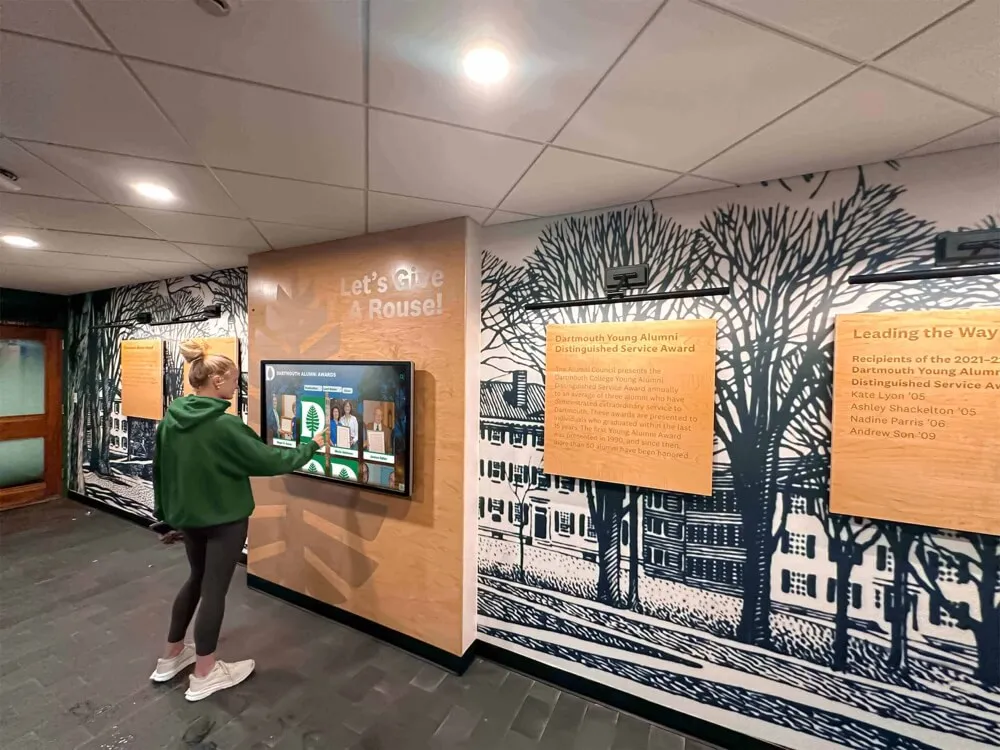
Technical Maintenance for Digital Systems
For institutions implementing digital recognition technology, establish protocols ensuring regular screen cleaning maintaining professional appearance, periodic software updates and security patches, hardware inspections and preventive maintenance, content backups and disaster recovery procedures, and technical support access for troubleshooting when issues arise.
Most digital recognition systems prove highly reliable with minimal intervention required, but proactive maintenance prevents small issues from becoming significant operational problems.
Future Trends in Donor Recognition Technology
Recognition technology continues evolving, with emerging capabilities promising enhanced engagement, improved fundraising integration, and innovative approaches to honoring generosity meaningfully.
Artificial Intelligence and Personalization
Forward-looking recognition systems incorporate AI enabling personalized content recommendations based on visitor interests, natural language queries for conversational donor discovery, predictive analytics identifying likely major gift prospects, and enhanced social integration extending recognition reach through donor networks.
Organizations implementing modern digital platforms now position themselves to adopt these enhancements as they mature without requiring complete recognition system replacement, protecting initial investments while maintaining system currency.
Mobile Integration and Global Accessibility
Companion mobile applications extend recognition beyond fixed displays through alumni directory access anywhere, event integration featuring relevant recognition during gatherings, notification systems alerting users when honorees from their eras are added, and offline access allowing content viewing without internet connectivity.
Web-based recognition platforms provide 24/7 accessibility from any device globally, enabling family members, employers, and professional networks to view donor acknowledgment easily. This extended reach strengthens recognition impact while facilitating reconnection among graduates who’ve maintained philanthropic relationships with institutions but lost personal contact over years.
Conclusion: Recognition That Inspires Lasting Philanthropy
Alumni donors provide the philanthropic foundation enabling educational institutions to fulfill missions, expand programs, enhance facilities, and serve students effectively. When these generous supporters invest financially in institutional futures—often while managing competing personal obligations—their contributions deserve recognition honoring both the gifts and the emotional connections motivating generosity.
The most effective alumni donors walls of honor eliminate forced choices between acknowledging some supporters while ignoring others due to space limitations. Modern recognition technology enables institutions to celebrate every contribution, honor every donor, and preserve every moment of generosity comprehensively.
Whether implementing traditional plaques, cutting-edge digital displays, or hybrid approaches combining elements of both, fundamental principles remain constant: meaningful recognition that celebrates philanthropic achievement, preserves donor legacies permanently, and inspires continued generosity strengthening institutional communities for generations.
Educational institutions ready to transform donor recognition can explore purpose-built solutions combining intuitive technology, professional support, and proven advancement best practices. These platforms enable organizations to honor generosity appropriately while building recognition traditions that strengthen fundraising outcomes, engage alumni communities, and inspire future supporters to join philanthropic legacies transforming educational missions.
Every alumni donor deserves recognition for their commitment to institutional success. Modern recognition systems make comprehensive celebration possible, ensuring no generous contribution disappears from organizational memory due to artificial capacity constraints. The best donor recognition walls don’t just acknowledge past giving—they inspire future philanthropy that sustains institutional excellence across generations.
